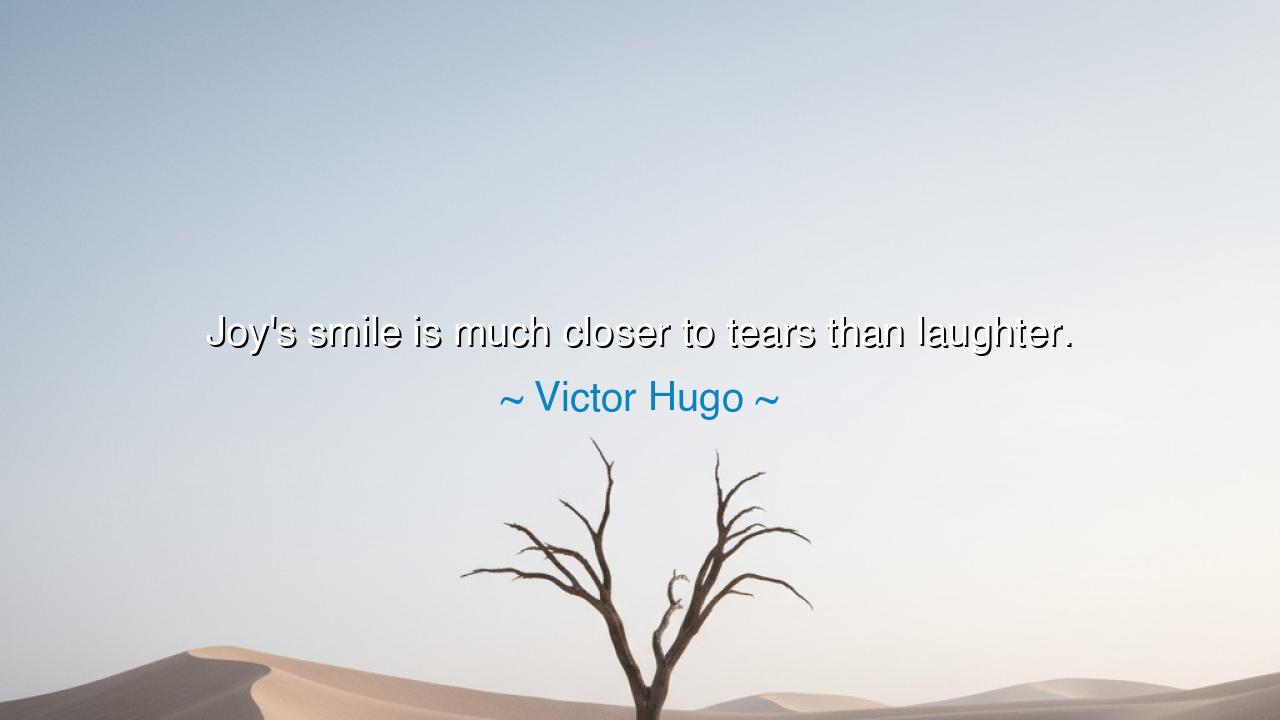
Joy's smile is much closer to tears than laughter.






The words of Victor Hugo, “Joy’s smile is much closer to tears than laughter,” are heavy with the wisdom of the human heart. In this simple yet profound image, he reminds us that joy is not the shallow pleasure of amusement, nor the fleeting spark of laughter, but a deeper current, born of struggle, longing, and release. The smile of joy is tender, fragile, and luminous, for it often arises on the edge of sorrow. When the soul has suffered and endured, and then at last tastes light again, its smile trembles—not with mockery or noise—but with the stillness of near-tears.
The ancients understood that joy is not mere laughter. Laughter can be easy, even careless, springing from jest or folly. But joy—the true joy Hugo describes—often comes only after pain. The mother who smiles at her newborn after long hours of labor, the soldier who embraces his family after years of war, the exile who returns at last to his homeland—these smiles are radiant, but they are also wet with tears. Joy, in its fullness, carries within it the memory of suffering, and thus stands closer to tears than to laughter.
History offers us striking examples. When Nelson Mandela walked free from prison after twenty-seven years, the crowds erupted in celebration. Yet those who looked into his face saw not unrestrained laughter, but a quiet, almost tearful smile. It was the smile of one who had borne unimaginable sorrow, yet now stood in the sunlight of freedom. His joy was vast, but it was solemn too, because it carried the weight of all that had been lost. Hugo’s words capture this paradox perfectly: joy’s smile is fragile, trembling, because it remembers what it has endured.
There is also within this saying a reminder of our own hearts’ complexity. Too often, people believe happiness is loud, constant, and exuberant. But the deepest happiness is gentle, often mingled with sadness, because it recognizes how precious life is. To cry and to smile at the same moment is not weakness—it is the sign of a soul awakened. Hugo, who wrote of revolution, love, and exile, knew that true joy is born in the tension between pain and redemption.
The teaching is clear: do not mistake laughter for joy, nor assume that a tearful smile is sorrow. The two are intertwined. True joy often humbles us, making us weep as much as we smile, because it comes from a place where the soul has been tested and yet not destroyed. The one who can smile through tears is not fragile, but mighty, for they have tasted life in its fullness.
The lesson we may carry forward is this: embrace the depth of your emotions. Do not fear tears when they accompany your joy, for they reveal that your heart has been stretched wide enough to contain both sorrow and hope. When you see another smiling through tears, do not pity them, but honor them—for theirs is a joy far greater than laughter alone can hold.
To practice this wisdom, allow yourself to feel without restraint. When life gives you moments of profound joy, do not chase away the tears that may rise. Let them flow, for they are part of the beauty of the moment. Likewise, when you comfort others, look not only for laughter as a sign of healing, but also for that quiet, trembling smile that lives beside tears. That is the mark of a heart that has endured and yet still shines.
So remember, O children of tomorrow: joy’s smile is a sacred thing, fragile and radiant, trembling on the edge of sorrow. Do not seek only laughter, for laughter is fleeting. Seek instead the joy that carries tears within it—the joy that remembers suffering yet chooses to shine. For in that, you will find the deepest and most enduring form of happiness.






AAdministratorAdministrator
Welcome, honored guests. Please leave a comment, we will respond soon